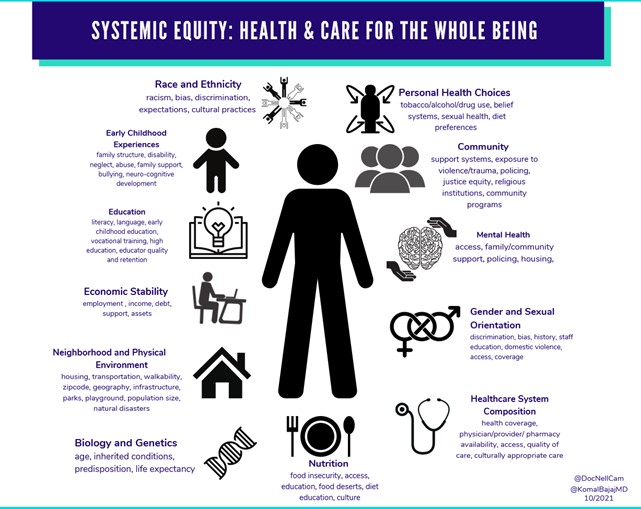Why It Matters

Photo by Agence Olloweb | Unsplash
The Obstetrics & Gynecology Department of a suburban hospital decided to improve breast cancer screening with a goal of increasing the number of women who get screened by 10 percent over 6 months. At the end of six months, they saw an overall improvement of 15.4 percent in the number of women who get screened. Two months after the improvement was reported at the quarterly Quality Assurance/Performance Improvement meeting, a new director of the department’s QI team stratified the data by patient self-reported race and found that the rates of women who self-identified as Black decreased by 2 percent. The director discussed the implications of the new findings with the team, including the need to design PDSA cycles that appropriately address the disparity.
The scenario described above unfortunately occurs all too often in performance improvement. Aggregate analysis can show overall gains, but inequities in health and care can remain hidden until data is stratified using specific parameters including — but not limited to — race, ethnicity, ancestry, language, sexual orientation, and gender identity. Health care inequity is widespread for historical, political, geographical, and economic reasons. Unfortunately, quality improvement practitioners can inadvertently worsen inequities when we fail to acknowledge the unintended consequences that can arise when we do not apply a proactive equity framework to our projects.
Applying an Equity Lens
We can no longer be reactive in considering the potential for inequitable impacts. In “Ingraining Equity into Quality and Safety: A System-Wide Strategy,” one of the four steps recommended for embedding equity into quality and safety work is to apply equity frameworks to key existing quality and safety workstreams. Projects designed without an intentional focus on equity promotion may foster intervention-generated inequalities that further disadvantage historically marginalized groups. The proactive application of an equity lens — in other words, framing and analyzing qualitative and quantitative socioeconomic conditions of patients in such a way to improve processes and outcomes when designing interventions with the goal to mitigate inequities. This is essential to driving the design of PDSA cycles to address any emerging disparities.
To achieve systemic equity through the application of an equity lens, it is imperative that REAL SOGI (race, ethnicity, ancestry, language, sexual orientation, and gender identity) data is collected, up to date, and utilized throughout the hospital system. Since this information can be sensitive for patients to divulge, adequate training for staff who collect this data is essential. Barriers to data entry, such as difficult to navigate electronic health records and patient portal interfaces, should be eliminated for patients and health care teams. The data should be readily accessible to the interprofessional teams that care for patients.
Deciding how to implement the use of equity lenses can be daunting depending on the team’s experience. There are important questions that need to be asked once the initiative has been decided upon, including:
- What inequities already exist in the context of this initiative?
- Where do I find equity frameworks to use?
- Which equity lens or lenses will be used?
Figure 1 highlights the multiple equity lenses that can be used for performance improvement projects. It is evident that within each category of equity lenses, there are many subcategories that can help to define one lens to use throughout a project. It would not be practical to focus on all the equity lenses shown in the graphic. However, a team could choose one lens focused on an area where inequities are known or anticipated. Also, it can be useful to use one lens for multiple projects to show if there are any inequities specific to that lens.
When policy changes are made based on aggregate data from quality improvement, patients become receivers of those policies instead of active contributors to them. Choosing a specific equity lens at the beginning of a quality improvement project centers the experiences of vulnerable patient groups. Utilizing an equity lens in quality improvement allows the collective patient experience to be included as a stakeholder.

Figure 1. Systemic Equity: Health & Care for the Whole Being [Source: NYC Health + Hospitals]
Challenges
No initiative can be successful without a proper framework for data collection. REAL SOGI data collection infrastructures include the electronic health record and patient portals and can take place through inpatient and ambulatory care settings. The data collection process can pose some challenges such as informatics, lack of staff familiarity with dashboards, patient awareness and utilization of patient portals, and staff and patient comfort with asking and answering questions respectfully. For example, staff collecting data from patients about biological body parts must be trained to be sensitive, respectful, and clear in explaining why, how, and where this data will be used to support their health care.
Another challenge that will arise is keeping the system up to date as new definitions surrounding REAL SOGI data emerge. The advantage to keeping this data dynamic is to allow for more inclusivity and more specificity when applying the equity lenses. Unfortunately, there is a dilemma when society changes faster than our data systems can update and restructure.
Looking Forward
Achieving systemic equity in health care through utilizing equity lenses can be a challenge since there are so many moving parts in the effort. However, as quality and safety professionals, we can no longer be ignorant to the role we play in contributing to health care disparities by celebrating achievements that leave behind vulnerable patient populations. We must engage patients as more than just consumers and recognize that their whole being and lived experience is essential to quality improvement.
Linelle Campbell, MD, MS, is Director of Equity, Quality & Safety at New York City Health + Hospital/Jacobi/North Central Bronx (@DocNellCam). Eric K. Wei, MD, MBA, is Chief Quality Officer at New York City Health + Hospitals (@DrEricWei). Christopher Montgomery, MPH, is an Assistant Health Care Program Planner Analyst at New York City Health + Hospitals (@cmonte1026). Michelle Morse, MD, MPH, is Chief Medical Officer and Deputy Commissioner for the Center for Health Equity and Community at the NYC Department of Health Wellness (@michellemorse). Komal Bajaj, MD, MS-HPEd, is Chief Quality Officer at NYC Health + Hospitals/Jacobi and Clinical Director of Simulation (@KomalBajajMD).
Editor's note: Join the authors at the IHI Forum 2021 session A03: From Theory to Impact: Ingraining Health Equity Into Quality and Safety at NYC Health + Hospitals on Tuesday, December 7 from 1000-1100 Eastern Time.
You may also be interested in:
Linking Quality, Safety, and Wellness Through Health Care Debriefing
